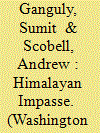| Srl | Item |
| 1 |
ID:
191792


|
|
|
|
|
| Summary/Abstract |
The Sino-Indian rivalry traces its origins to the founding of each state in the late 1940s. Over the past decade Indian concerns over Chinese activities in South Asia have significantly increased. While New Delhi has sought to counter Beijing in South Asia, a key question is to what extent has China responded to India in the same region? Do we find evidence of a tit-for-tat rivalry escalation process in South Asia where both China and India are actively trying to counter each other? The central argument in this article is that China is not actively engaging in a direct form of rivalry reciprocity with India. While certain activities by Beijing in the region are designed to enhance Chinese influence and power, there is less evidence that these are a direct response to India. This is in contrast to New Delhi’s behavior in the region where we do find evidence of Indian leaders directly responding to China. This articles’ main contribution is to demonstrate that maintenance in asymmetrical positional rivalries does not require clearly identifiable points of escalation, or follow a linear path of a tit-for-tat action-reaction cycle.
|
|
|
|
|
|
|
|
|
|
|
|
|
|
|
|
| 2 |
ID:
162695


|
|
|
|
|
| Summary/Abstract |
In mid-June 2017, Bhutanese authorities detected Chinese personnel, presumably members of the People’s Liberation Army (PLA), building a road in a disputed region of the Doklam plateau near the Bhutan-China-India tri-junction. Lacking the military wherewithal to prevent the activity underway, Bhutan turned to India for assistance.1
1 Vidhi Doshi and Simon Denyer, “China Pushes Hard in Border Dispute with India,” Washington Post, July 6, 2017, https://www.washingtonpost.com/world/asia_pacific/china-pushes-hard-in-border-dispute-with-india/2017/07/06/52adc41e-619b-11e7-80a2-8c226031ac3f_story.html?noredirect=on&utm_term=.0e4267c15214.
View all notes
Within days, Indian Army units were deployed to the area to halt the road construction. Over the next month or so, Indian and Chinese military units became involved in a close confrontation with neither side displaying any interest in standing down. Eventually, the Chinese stopped their activity toward the end of August but did not abandon their claims to the disputed areas.
|
|
|
|
|
|
|
|
|
|
|
|
|
|
|
|
| 3 |
ID:
135502


|
|
|
|
|
| Summary/Abstract |
The scale of petroleum consumption between the two countries levies a continuing impact upon the reserve of hydrocarbons; the competition between the two countries has often led to an inflated price in energy deals and; the fact that fossil fuels like coal form the mainstay of the Chinese and Indian energy consumption pattern and the impact of this energy use pattern on the environment are all likely impacts that need to be considered.
|
|
|
|
|
|
|
|
|
|
|
|
|
|
|
|
| 4 |
ID:
144203


|
|
|
|
|
| Summary/Abstract |
Recent literature has aimed to “deconstruct” the notion of a “Sino-Indian rivalry” in Myanmar. The argument is that China's leverage in Myanmar far outweighs India's, and that the Tatmadaw nevertheless prevents either country's manipulation of Myanmar. In contrast this article argues that the idea of a “Sino-Indian Great Game” still marks the Indian debate, thinking and policy on Myanmar. China's continued rise will remain a main driver behind India's Myanmar policy, and Myanmar will remain geostrategic relevant to India.
The article describes the historical legacy of India's relationship with Myanmar, discusses the role of China in Indian Myanmar policies, and examines the effects of Myanmar's democratization process. While the Myanmar playing field has changed, Indian perceptions of a “Sino-Indian Great Game” are lasting.
|
|
|
|
|
|
|
|
|
|
|
|
|
|
|
|
| 5 |
ID:
169248


|
|
|
|
|
| Summary/Abstract |
Sino-Indian interactions after the mid-19th century had a causal influence on Chinese and Indian elite perceptions. Modern China encountered modern India as an agent of British imperialism. China perceived India as an “imperial” power in the late 1940s by resorting to the availability heuristic while doubting India’s intentions in Tibet/Southeast Asia. By contrast, India viewed China as a fellow victim of colonialism that had sought India’s help during World War II. Consequently, India perceived China as a “partner” in postwar/postcolonial Asia. This interpretation was based on confirmation bias after 1947, despite contradictory Chinese signals. India’s image of China changed only after the 1950–51 invasion/annexation of Tibet. India then ascribed the image of an “expansionist/hegemonic” power to China based on historical analogy. Nevertheless, they carefully calibrated their strategies towards each other in consonance with these images until the 1959 Lhasa Uprising, thereby preventing their relationship from descending into militarized hostilities.
|
|
|
|
|
|
|
|
|
|
|
|
|
|
|
|